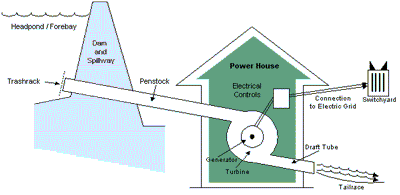Definition
There is no international consensus on the definition of small scale hydropower. In Canada 'small scale' can refer to upper limit capacities of between 20 and 25 MW, whereas in the United States 'small scale' can mean 30 MW. However, a value of up to 10 MW total capacity is becoming generally accepted. Small scale hydropower can be further subdivided into mini hydro (usually defined as <500kW) and micro hydro (<100kW). No matter how you define it one thing remains the same, small scale hydropower is one of the most environmentally benign forms of energy generation available to us today. The Hydropower section of IPCC’s 2011 Special Report on Renewable Energy Sources provides further discussion on this topic – refer to Sections 5.3.1 and 5.3.2.
Small scale hydropower systems capture the energy in flowing water and convert it to usable energy. Although the potential for small hydro-electric systems depends on the availablity of suitable water flow, where the resource exists it can provide cheap clean reliable electricity. A well designed small hydropower system can blend with its surroundings and have minimal negative environmental impacts.
Moreover, small hydropower has a huge, as yet untapped potential in most areas of the world and can make a significant contribution to future energy needs. It depends largely on already proven and developed technology, yet there is considerable scope for development and optimization of this technology.
How does it work?
Hydropower systems use the energy in flowing water to produce electricity or mechanical energy. The water flows via channel or penstock to a waterwheel or turbine where it strikes the bucket of the wheel, causing the shaft of the waterwheel or turbine to rotate. When generating electricity, the rotating shaft, which is connected to an alternator or generator, converts the motion of the shaft into electrical energy. This electrical energy may be used directly, stored in batteries, or inverted to produce utility-quality electricity. A small scale hydroelectric facility requires that a sizable flow of water and a proper height of fall of water, called head, is obtained without building elaborate and expensive facilities. Small hydroelectric plants can be developed at existing dams and have been constructed in connection with river and lake water-level control and irrigation schemes. By using existing structures, only minor new civil engineering works are required, which reduces the cost of this component of a development.

Parts of a small scale hydropower facility
Photo courtesy of RETScreen International - Small Hydro Model
In other, more rugged regions of the country, it is possible to develop relatively higher heads without elaborate or expensive civil engineering works so that relatively smaller flows are required to develop the desired power. In these cases, it may be possible to construct a relatively simple diversion structure and obtain the highest drop by diverting flows at the top of a waterfall or steeply falling watercourse.
Benefits of Small-Scale Hydropower
Hydroelectric systems provide the following general benefits:
- Hydroelectric energy is a continuously renewable electrical energy source.
- Hydroelectric energy is non-polluting - no heat or noxious gases are released.
- Hydroelectric energy has no fuel cost and with low operating and maintenance costs, it is essentially inflation proof.
- Hydroelectric energy technology is a proven technology that offers reliable and flexible operation.
- Hydroelectric stations have a long life and many existing stations have been in operation for more than half a century and are still operating efficiently.
- Hydropower station efficiencies of over 90% are achieved making it the most efficient of energy conversion technologies.

